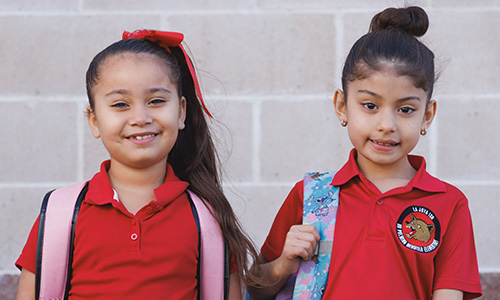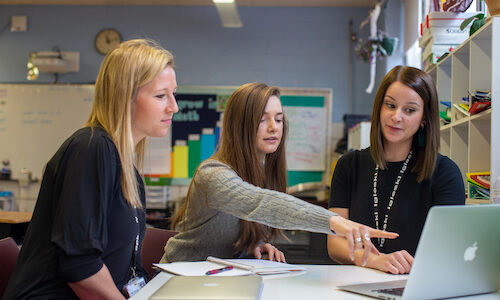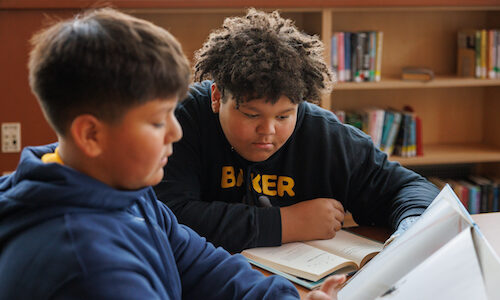
Under my bed at my parent’s house, there is a big, flat box full of my preschool and elementary school work. Every now and then, I root through those items, recalling projects and activities I did as a child. Maybe it is the teacher in me or maybe I’m just very sentimental, but even as an adult I find myself reflecting on my work and growth throughout my schooling.
I feel fortunate to have had an amazing student-teaching experience when I was starting my career. I was placed in the same second-grade classroom that I shadowed every day as a high school senior. It was in the elementary school I went to as a child. (Full circle, right?) My mentor teacher, Mrs. DiPerna, was (and still is) everything I aspire to be as an educator. I learned so much while in her classroom that I still find myself asking, “What would Mrs. DiPerna do?” when I’m thinking through classroom decisions.
Two incredibly impactful practices that I took away from my experience in her classroom were student portfolios and student-led conferences. Both of these practices are student centered and provide natural opportunities for student reflection. Once structures are in place, they are easy to plan and execute, and I would recommend them to any teacher looking to enhance their student ownership. Let me give you a crash course on how both practices operate in my third-grade classroom.
Student portfolios
What?
Each student in our class has a two-inch binder that has sections to keep the kids organized: Data & Goals, Reading, Writing, Math, Content, and Other. Each section starts empty, but as the year goes on, they are filled with artifacts of work, assessments, projects, and school memories.
Here are some examples of what we include in each section:
Data & Goals
- MAP® Growth™ score reports
- MAP Growth score graphing
- State testing data
- Self-reflections
- Learning styles inventory
- Flexible seating preferences
- Goals sheets/tracking tools
- Summative assessment graphs
Reading
- Reading reflections
- Reading projects
- Reading assessments
- Rubrics for stop and jots
- Reading logs
- Book reports
- Summaries
- Graphic organizers
Writing
- Planning organizers
- Rough drafts
- Published writing with rubrics
- Any seasonal or free-writing artifacts
Math
- Diagnostics
- Summative assessments
- Math crafts
- Math projects
- Fact fluency assessments
Content
- Notes and lesson activities
- Research
- Projects
- Summative assessments
Other
- STEM activities
- SEL activities
- Classroom photos
- Holiday items
- Any other work they feel proud of!
Why?
We use portfolios in my classroom because we have seen students doing higher quality work and feeling more pride over their work when they do. They know that their work will go in a special place and not end up in the bottom of their backpacks or in the recycle bin. They feel ownership over selecting work to add to their portfolio and they add it themselves. The kids look forward to taking home their binder full of work at the end of the year. We have seen them show their binders to friends in excitement and pride. I like to think of these binders as scrapbooks of learning!
Portfolios also provide a wonderful opportunity to practice organization skills, as kids are the ones filing their work into the correct section and keeping their binder tidy.
How?
We use either our classroom funds to buy binders at the start of the year or we put them on the supply list for families. At the beginning of the year, we make copies of the cover page and the dividers. We let the kids decorate their binder cover and their dividers to make their special portfolio theirs. The divider pages are put into sleeve protectors, and we put sticky note tabs to help mark them.
Throughout the year, students add pieces of work to their portfolios. Sometimes we select items and sometimes the kids decide.
Student-led conferences
What?
Student-led conferences are one of my favorite things to do with students. We offer spring conferences, completely student led. Students utilize an agenda that has talking points, and they use their portfolio as a centerpiece to share their learning with their families and teacher(s).
Why?
These meetings reinforce the idea that we are all on a team together to support and cheer on a student. I love that student-led conferences promote academic and growth mindset conversations between all members of our team. Students see that they are in control of their learning, and they feel the support that the adults in their lives provide. The best part is, they have complete ownership of what they share with their team and they feel so proud to be able to lead a meeting.
On occasion, we have had some families who do not sign up. In these situations, the student leads a conference for the teachers and we make a recording to email home. We then send the portfolio home for the student to share bookmarked artifacts with their family. With students excited and empowered to share their hard work, we create a new opportunity to increase parent involvement in school life. It’s a win-win!
How?
Ahead of the conference, students pick five artifacts in their portfolio to bookmark. They write why they feel proud of each item. They use sticky notes to mark other items on their conference agenda.
We, as teachers, model leading a conference with a sample portfolio. We model and discuss speaking and presenting skills when leading a meeting. Then, we have them buddy up with a classmate and have them practice with a mock conference. The confidence and communication skills kids gain through this exercise always amaze me.
We utilize a sign-up (like SignUpGenius) with time slots after school or on teacher work days so families can select a slot. Alternatively, I have seen teachers invite parents in during the school day for conferences with just parents and students while teachers circulate the room. I personally prefer to be a part of the conference to promote that school–home connection. Regardless, once parents or other caregivers are there, the student takes the lead and you become an audience member!
At the end of a conference, students hand their adults a reflection paper with “Two stars and a wish” to gain positive feedback and reflection from their grown-ups about their school year.
Student reflection and ownership is the goal
I am forever grateful I gained these two practices from my student-teaching experience. Each year I am immensely proud of the growth I see in the kids I teach. What’s more important is that they feel proud of themselves and what they accomplished in the school year.
Student portfolios and student-led conferences promote reflection, ownership, confidence, connection, and pride. My hope is that my students walk away from my classroom feeling all of these things as they grow and move into their next academic stage.







